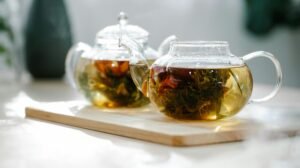How to Brew the Perfect Cup of Green Tea
Green tea is not just a beverage; it’s a tradition steeped in history and health benefits. Brewing the perfect cup requires finesse and understanding of both the tea itself and the method used. At [Your Company Name], we’re passionate about delivering the ultimate green tea experience. Here’s our comprehensive guide to brewing green tea that guarantees a delightful cup every time.
Choosing the Right Green Tea
The journey to a perfect cup of green tea starts with selecting the right variety. There are several types to consider, each offering unique flavors and characteristics:
Sencha
Sencha is the most popular green tea in Japan, known for its refreshing taste and vibrant green color. It’s harvested early in the season, giving it a delicate sweetness and grassy aroma.
Matcha
Matcha is powdered green tea, traditionally used in Japanese tea ceremonies. It offers a rich, umami flavor and is packed with antioxidants since it involves consuming the entire tea leaf.
Dragon Well (Longjing)
Dragon Well tea from China is pan-fired, resulting in a smooth, toasted flavor with a hint of chestnut. Its flat, jade-colored leaves brew into a pale green infusion that is soothing and gentle.
Gyokuro
Gyokuro is a shade-grown Japanese green tea, known for its sweet flavor and low astringency. The shading process enhances its chlorophyll content, giving it a vibrant green color and mellow taste.
Water Quality and Temperature
Once you’ve chosen your green tea, the next crucial step is preparing the water. Use filtered water to ensure purity and better taste. The ideal water temperature varies depending on the type of green tea:
- Sencha and Dragon Well: 75-80°C (167-176°F)
- Matcha: 70-75°C (158-167°F)
- Gyokuro: 50-60°C (122-140°F)
Boiling water can scald the delicate leaves and result in a bitter brew, so it’s essential to use a thermometer or an electric kettle with temperature control.
Brewing Techniques
Sencha and Dragon Well
- Measure: Use approximately 1 teaspoon of tea leaves for every 8 ounces of water.
- Steep: Steep the leaves for 1-3 minutes, depending on your preference for strength. Shorter steeping times result in a lighter, more delicate flavor.
- Enjoy: Strain the leaves and savor the vibrant, grassy notes of Sencha or the nutty sweetness of Dragon Well.
Matcha
- Sift: Sift 1-2 teaspoons of matcha powder into a bowl to remove any clumps.
- Whisk: Add 2 ounces of hot water (not boiling) and whisk in a zigzag motion until frothy.
- Experience: Enjoy the creamy texture and rich, umami taste of traditional matcha.
Gyokuro
- Prepare: Use a higher tea-to-water ratio with Gyokuro, around 2 teaspoons per 6 ounces of water.
- Infuse: Steep Gyokuro for 1-2 minutes in cooler water to extract its delicate flavors slowly.
- Delight: The result is a sweet, smooth tea with a lingering umami taste and refreshing aroma.
Serving and Enjoying
To fully appreciate your perfectly brewed green tea:
- Serve Immediately: Green tea is best enjoyed fresh.
- No Milk or Sugar: Unlike black tea, green tea is typically served without milk or sugar to appreciate its natural flavors.
- Pairing: Green tea pairs well with light snacks like mochi, fruits, or delicate pastries to complement its subtle taste.
Mastering the art of brewing green tea takes practice and a passion for excellence. With these tips from [Your Company Name], you can elevate your tea experience and enjoy the health benefits and flavors of green tea at their finest.
Health Benefits of Green Tea
Beyond its delightful taste, green tea offers numerous health benefits backed by scientific research:
- Antioxidants: Green tea is rich in antioxidants like catechins, which help fight cell damage and reduce the risk of chronic diseases.
- Weight Management: The catechins in green tea can boost metabolism and aid in fat burning, making it a popular choice for those looking to manage weight.
- Heart Health: Regular consumption of green tea may lower LDL cholesterol levels and reduce the risk of cardiovascular diseases.
- Brain Function: The combination of caffeine and L-theanine in green tea can improve mood, focus, and cognitive function.
- Immune Support: The polyphenols in green tea have antimicrobial properties that support immune health.

Storage Tips for Green Tea
To preserve the freshness and flavor of your green tea:
- Store in airtight containers: Keep your green tea in a cool, dark place away from sunlight and moisture.
- Avoid odors: Green tea leaves can absorb surrounding odors, so store them away from strong-smelling items.
- Use within a year: For optimal flavor, consume your green tea within a year of purchase.
Choosing Accessories
Enhance your green tea brewing experience with the right accessories:
- Teapot: Opt for a ceramic or glass teapot that retains heat well and allows you to watch the leaves unfurl.
- Tea Infuser: For loose-leaf green tea, use a fine mesh infuser or a tea ball to contain the leaves while steeping.
- Matcha Set: Invest in a traditional matcha set, including a whisk (chasen) and bowl (chawan), for preparing ceremonial matcha.
Conclusion
Brewing the perfect cup of green tea is an art that combines knowledge, technique, and appreciation for one of the world’s most beloved beverages. Whether you prefer the fresh, grassy notes of Sencha, the creamy richness of Matcha, or the delicate sweetness of Gyokuro, mastering the brewing process ensures a delightful tea-drinking experience every time.
At [Your Company Name], we are committed to sharing our passion for green tea and helping you elevate your tea rituals. Explore our selection of premium green teas and accessories to embark on a journey of flavor and wellness.
Green Tea Ceremony: Tradition and Elegance
In Japan, the preparation and consumption of green tea are often elevated to an art form, known as the tea ceremony (chanoyu). This centuries-old tradition emphasizes harmony, respect, purity, and tranquility. Key elements of the tea ceremony include:
- Preparation: The meticulous preparation of matcha involves precise measurements, graceful movements, and a deep respect for the tea and its guests.
- Presentation: The tea is served in handmade ceramic bowls (chawan) and accompanied by traditional Japanese sweets (wagashi).
- Etiquette: Guests participate in a silent appreciation of the tea’s aroma, taste, and the craftsmanship of the utensils.
Participating in a tea ceremony not only enhances your understanding of green tea but also cultivates mindfulness and a deeper connection with Japanese culture.
Tea Gardens and Sustainability
The journey of green tea extends beyond its consumption. Tea gardens, especially in Japan and China, are meticulously maintained ecosystems that contribute to environmental sustainability:
- Organic Cultivation: Many tea farms practice organic and sustainable farming methods to preserve soil health and biodiversity.
- Water Conservation: Efficient water management techniques ensure minimal water usage while maintaining optimal tea growth.
- Community Impact: Tea gardens often support local communities by providing employment and preserving cultural traditions.
By choosing green tea sourced from sustainable gardens, you not only support environmentally friendly practices but also enjoy tea that reflects a commitment to quality and ethics.
Exploring Green Tea Varieties
Beyond the well-known types like Sencha and Matcha, there are numerous regional variations and blends to discover:
- Hojicha: Roasted green tea with a nutty flavor and low caffeine content, perfect for evenings.
- Genmaicha: Green tea combined with toasted brown rice, offering a unique, slightly savory taste.
- Jasmine Tea: Green tea scented with jasmine flowers, imparting a delicate floral aroma and taste.
- Mint Green Tea: A refreshing blend of green tea leaves and peppermint, ideal for digestion and relaxation.
Each variety brings its own nuances and benefits, enriching your tea-drinking experience with diversity and flavor.
Green Tea in Culinary Delights
Green tea’s versatility extends beyond a comforting beverage. It is increasingly used in culinary creations worldwide:
- Green Tea Ice Cream: A popular Japanese dessert known for its creamy texture and subtle green tea flavor.
- Green Tea Smoothies: Blended with fruits and yogurt for a nutritious and antioxidant-packed breakfast or snack.
- Green Tea Cake: Light and airy cakes infused with green tea powder or brewed tea for a delicate sweetness.
- Green Tea Marinades: Enhance the flavor of meats or tofu with a marinade made from brewed green tea, soy sauce, and spices.
Experimenting with green tea in recipes allows you to explore its culinary potential and integrate its health benefits into your daily meals.

Conclusion
Brewing and enjoying the perfect cup of green tea is a journey of exploration, health, and culture. Whether you’re drawn to its antioxidant properties, its rich history, or its diverse flavors, green tea offers something for everyone. At [Your Company Name], we invite you to embrace this timeless tradition and discover the joys of green tea through our curated selection of premium teas and accessories.















